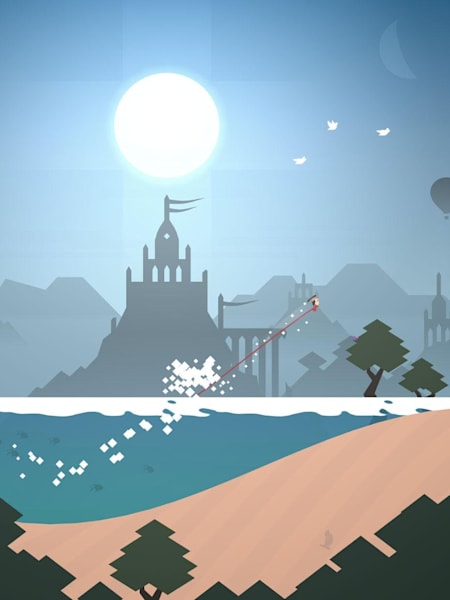Gaming
It’s been a busy few months for Team Alto and Snowman, the Canadian developers behind the gorgeous snowboarding titles Alto’s Adventure and Odyssey, with the latter finally released on iOS after a long wait for the series’ dedicated fans. Now, a few months later, it’s time for Alto to hit Android. But why the wait, what are the changes made to the ‘boarding epic, and will Snowman be developing for consoles?
We speak with Ryan Cash, Founder of Snowman, Harry Nesbitt, Lead Artist & Developer, Team Alto, and Ryan Holowaty, COO of Noodlecake, the team that helped bring Alto to Android, to find out more.
How did you find the critical and audience reception to Alto’s Odyssey?
Cash: We’ve been absolutely thrilled with the response to the game so far.
We had a really delicate line to balance, as we didn’t want to create something that was too different from the original, yet we wanted to create a new space for existing Alto fans to come and interact with in new ways. The fan reception has been incredible so far, and at the end of the day, that’s what matters most to us.
Winning the Apple Design Award in June was also a really big moment for us. Receiving recognition for our game’s design by arguably the best design company in the world was really a special moment for us.
Given the long wait between Adventure and Odyssey, do you think there’ll be a similar one between this and your next project? What’s next for you guys?
Nesbitt: We definitely think it takes time to get things right, especially as a small team. We always want to make sure we’re managing our creative energy – a finite resource – to produce the absolute best work we’re capable of. This often means being selective, and waiting for the right idea to strike at the right time.
Alto will always be close to our hearts, but there’s a definite excitement on both sides of the Team Alto collaboration to explore further ideas and experiment with new ways to deliver experiences.
For me, this means going back to the drawing board, challenging my preconceptions and asking myself what kind of games I’d really love to make.
Cash: On the Snowman front in general, we’re hard at work on a few other games, including Skate City, Where Cards Fall, and DISTANT. For us, it’s important the games are as refined and polished as people have come to expect from Snowman, and sometimes that can take a long time. The last 10 percent is really where the magic happens, and sometimes that 10 percent can actually take 90 percent of the time.
Will your work continue to be on mobile games, or will you look to work with consoles in the future?
Cash: While our focus has always been on mobile since we started Snowman in 2012, we’ve definitely started dipping our feet into other 'ponds'. The Apple TV was the our first foray into the living room, and I definitely think that sparked some newfound interest for us. We really enjoy the innate constraints that mobile games present and the design challenges that come with it, but we’re also interested in exploring other platforms. We’ve already announced that DISTANT will come to consoles, although I don’t have any further information on the details of that at the moment.
Alto’s now coming to Android. Why the wait between iOS and Android?
Cash: As a small team we have to prioritise shipping on one platform to start, otherwise it’d just take us longer to get the game out the door initially. On top of that, Apple’s ecosystem is definitely our bread and butter, and where a lot of our team’s experience comes from (a couple of us worked in the Mac business software industry before working in games), and so it’s a natural first option for us. On top of that, iOS continues to be the easiest platform to develop for, with a lot less hardware and software fragmentation, and a consumer base that’s willing to pay for premium games.
You guys worked with Noodlecake Studios again to deliver the Android version; how has that collaboration been? Smoother than when you guys were cooking up Adventure for Android? What obstacles did you guys have to overcome?
Cash: Our collaboration with Noodlecake has always been really great. Not only are they great (Canadian!) guys, but they share the same design philosophies that we have. It took us a bit longer to bring Alto’s Adventure to Android as we were caught fairly off guard with all of the post-launch chaos that ensued after Alto’s Adventure originally launched in February 2015. This time around our team is larger and we’re a little more prepared, and so we’d already firmed up our Android plans with Noodlecake ahead of our initial launch on iOS, something that took us about six months the first time.
What learnings did you take from Adventure’s Android version? That launched as a free-to-play title; will you be applying the same sort of strategy this time around?
I think we learned a lot launching Alto’s Adventure as a free-to-play title on Android. Since its initial launch we’ve made a few tweaks to the game structure, adapting the game a little based on player feedback and our learnings from the game’s launch. When we launch Alto’s Odyssey we’ll be able to take everything we’ve learned from Adventure over the last two and a half years and apply it from the get-go on day one.
From what we’ve seen so far though, the game has performed much better as a F2P title than it would have as a premium title on Android, based on anecdotal data from our friends in the indie game community. The other exciting thing about going F2P is the ability to reach much larger audiences. As of writing this, Alto’s Adventure has surpassed 35M downloads on Android.
Android screens come in all different sizes and form factors; did this give you guys any headaches when porting the game over?
Holowaty: This is one of the biggest issues with the Android platform to be honest. The variance of not only screen sizes but RAM, CPU and even things like how the touch screens react to inputs can vary wildly. It’s one of the main reasons many small development teams don’t handle Android themselves because the sheer scale of quality assurance testing needed is out of scope for many. We’ve been working with the platform over the years and amassed a mountain of devices that range from the super low-end to the most recent devices to hit the market. Plus we have become accustomed to make of the weird quirks of the platform that allow us to hit around 95 percent of devices out there.
Have you optimised the game to take advantage of any particular Android features?
Holowaty: Google Play's back end system allows us to run extensive beta testing to internal and external testers and gives us great insight into how players are going to experience Alto. This not only allows us to squash bugs before it goes live to the world, but craft a better playing experience. For example in Alto's Adventure, many players were complaining that the chasm jump in the tutorial was broken. On iOS this wasn't as big an issue because players who purchase the game are more willing to try the jump many times to get it right. With a free title, players are much quicker to delete the game the second something doesn't go right. So with the analytics we decided to make the jump a bit easier just to help with the onboarding of players. It resulted in a large percentage of our support emails disappearing and the star rating for the game increased.
We’re also taking advantage of the pre-registration system to allow players to be notified the minute the game is live.
What made you want to apply the F2P model in the first place? Were you guys worried about piracy at all?
Cash: Definitely. We had heard from others in the industry that they were seeing 5-25 percent (at the highest) revenue compared to iOS when launching a premium game in the Android market, and to us that just didn’t seem like something we were interested in. But beyond piracy, or perhaps 'non-paying customers', I think there’s something bigger at play. The iPhone is very much a middle (and upper) class device, whereas Android covers the entire class spectrum. I don’t have any statistics on this myself, and this isn’t professionally researched data or anything, but I think that Android phones are for everyone, and iOS devices are generally for middle to upper class people, just because of the price barrier to entry.
When making a F2P game (especially on Android) it allows you to reach everyone in the market, not just a subset of people. I think it’s really great that we can reach people that wouldn’t otherwise be able to purchase the game upfront, and at the same time be able to reach those that can. A lot of our downloads on Android have come from developing countries and it’s really cool that we’re able to reach these people.
So yeah, I don’t think it’s only about piracy and 'bad customers' – a lot of it just has to do with economics and average incomes. According to CEIC, the average monthly income in Indonesia is $183 USD [€ 157] (in 2017). It’d probably be irresponsible to spend $5 of that on a game, and therefore the majority of people there just can’t afford to purchase a premium game. It’s not because they’re bad customers – they’re just facing a different economic situation.
I think it’s great that these people can enjoy a game for free if they’re unable to purchase it outright, as play is such a fundamental human right that we want as many people to be able to experience.
Alto’s Odyssey is out on Android and iOS now.







